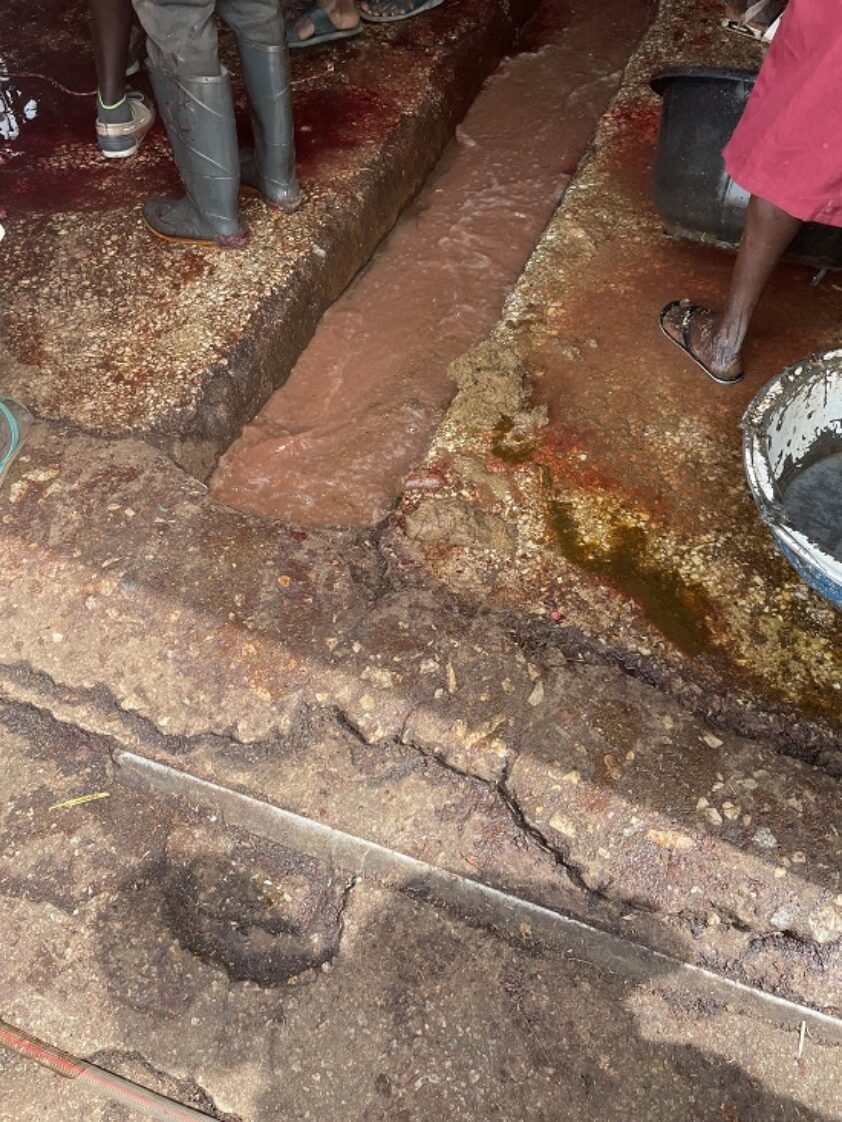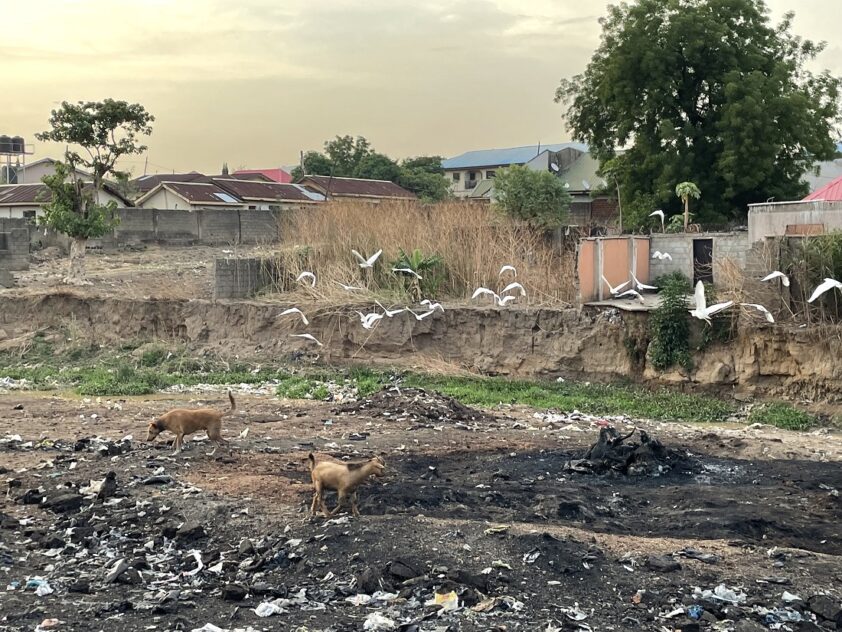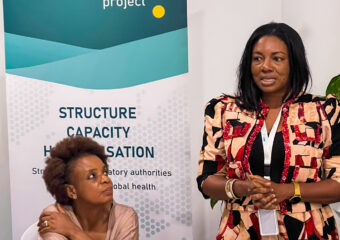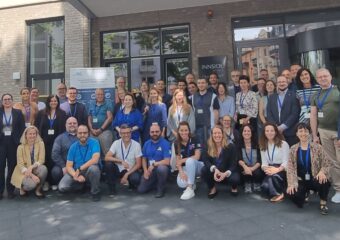Anthropological Report from the Field – Investigating Human-Animal-Environmental Interfaces at a Nigerian Abattoir
It is noon in a peri-urban area of Abuja, the capital of Nigeria. Two anthropologists from the NCDC and RKI are sitting on a bench among cattle and and passing goats and sheep, deep in conversation with animal dealers and regular workers from an abattoir. It is end of dry season and the merciless heat is exhausting the strength of all living creatures.

We stay where the animals stay, we eat where the animals eat, we drink the same water as the animals.
Our interlocutor tells us this while sitting on a wooden bench in the middle of the open cattle stables surrounded by his own animals and the ones from others. It is almost noon and we, Adeoye Adeponle and Hellena Debelts, the team of Nigerian and German anthropologists, sit next to him on his bench in the shadow of his wooden shed. No cloud breaks the steering blue of the sky and the temperatures already exceeded 35 degrees. It is end of dry season in Nigeria. Everybody is longing for the first cooling and nurturing rains.
The stable is a live animal market for big ruminants (cattle) and small ruminants (goat, ram, sheep) adjacent to an abattoir, a slaughter facility. Our interlocutor is an animal dealer. He buys cattle in the North of Nigeria, in big animal markets, to transport them via trucks back to Abuja, the capital of Nigeria. Here the animals stay for days up to weeks and months to be sold to regular customers and whoever comes and buys them. Most of the animal traders stay with their animals for almost every day of the year surrounded by the ever-changing livestock. In the early mornings the butchers come in their rubber boots to get pre-selected animals to lead them down their final path into the slaughter house. Slaughter is starting in the dark from 5:30 am to end at 11 am, to avoid the heat of the day and to start selling the fresh meat as early as possible. A Mallam, a specifically religiously trained man, comes to make the life ending throat cut to kill the animal in a halal way, to follow Muslim traditions of slaughter. After the animal bled out on the floor and a man collected the bright blood into a bucket a group of four to seven men start their work. They cut the animal open from head to tail, being positioned on its back on the paved floor, and then separate it quickly into smaller pieces with various tools, such as knifes, axes and machetes. Each group is working next to another. It is crowded and loud, from hacking and shouting, and the air is humid and hot. The drainages are constantly full of a brown liquid running out into the nearby stream. Women come in to bring water in black buckets on their head for the slaughter process and leave with other buckets full of meat or intestines. They bring it to buyers or to the small market place which is situated in-between the slaughter area and the stable. Some veterinarians and animal health inspectors, both deployed in the abattoir from the government, in yellow-brown or washed-out blue cotton uniforms, rubber boots, gloves, and face masks, make their way through the slaughter room to make post mortem checks. They stick out due to their protective gear and uniforms, since the other workers mostly wear everyday clothes and footwear. Where ever we stand to observe we are in the way of people following their part in this seemingly chaotic process for the untrained eye. Staying for a long period of time and using anthropological techniques such as observation, repeating questions, informal discussions, and interviews leads to a deeper and better understanding of every day realities. This way the researchers start to see, e.g., the order behind seeming chaos to understand processes and their reasoning behind them more clearly.

In the abattoir everything from the animals is recycled and exported all around Nigeria and the world – the meat and intestines for supermarkets, hotels and individuals, the skin for leather, the horns for cups and shoes, the blood for chicken and fish feed, the dung as fertiliser for farms. The abattoir and stable is a massive network of goods, animals and people coming in and out and hence, a very important and fascinating place for research on human and animal interactions, health and diseases

The anthropologists from the Robert Koch Institute (RKI) and the Nigeria Centre for Disease Control (NCDC) worked for over a month in the abattoir and stable, as well as in a neighbouring and rural primary health care facility, coming every day to sit and talk with people, to observe and to interview. The veterinarians Dr Valerie Allendorf, from the Friedrich Loeffler Institute (FLI), and Dr Olayinka Asala and his team Oluyemi Ogunmolawa, Jerry Ijomanta, and Joshua Seyi Oyetunde from the Nigerian National Veterinary Research Institute (NVRI), joint the fieldwork for taking various samples from animals. This research is part of a multi-disciplinary GHPP project called “Investigating human-animal-environment interactions under the lens of COVID-19 and One Health approaches in Nigeria, Côte d’Ivoire and Republic Democratic of Congo”. The multinational team works together to collect data about interfaces between humans, animals and the environment. The concept of interconnection between human health, animal health and environmental health is called One Health, which is important for working on zoonotic diseases, such as COVID-19, that can spill-over between animals and humans. For this project the scientists look into the three components of One Health in the abattoir and stable, as well as in the two clinics in FCT, to get a better understanding of their everyday lived realities. This data will help to inform outbreak preparedness and response policies in Nigeria and beyond.
Date: July 2022



